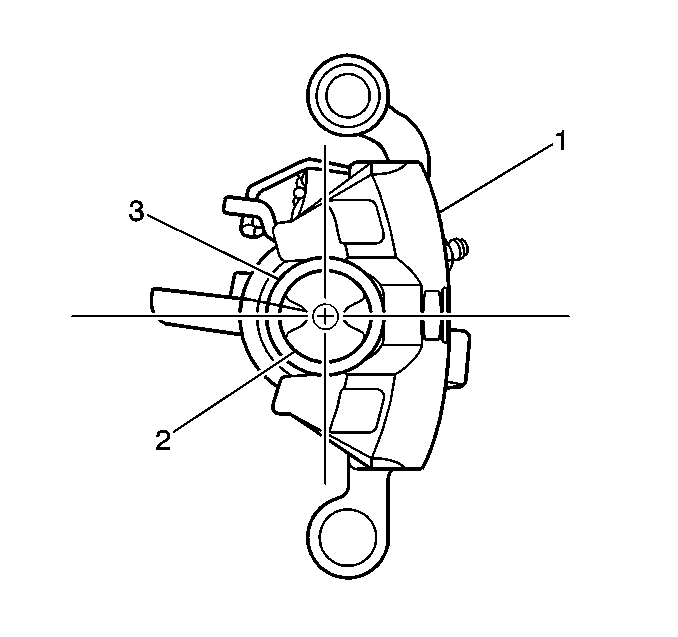Rear Brake Caliper Overhaul Without J55
- Remove the rear brake caliper from vehicle. Refer to Rear Brake Caliper Replacement .
- Remove piston (2) and piston boot (3) by turning the piston (2) counterclockwise using a spanner type wrench.
- Remove the boot ring from the groove in the caliper bore with a small wooden or plastic tool.
- Remove the caliper piston seal with a small wooden or plastic tool.
- Remove the piston boot from the piston.
- Remove the bleeder screw from the brake caliper body.
- Replace the lever return spring if damaged.
- The brake caliper piston is replaced as an assembly.
- Clean all of the parts with denatured alcohol.
- Dry all of the parts with non-lubricated, low pressure compressed air.
- Blow out all of the passages in the caliper body and the bleeder valve.
- Inspect the piston for scoring, rust , wear, damage, or presence of foreign objects. Replace the piston if any of these conditions have occurred.
- Inspect the inside surface of the cylinder for scoring, rust, wear, damage, or presence of foreign objects. Replace the caliper body if any of these conditions have occurred.
- Install the bleeder screw into the caliper body.
- Lubricate the new piston seal with clean brake fluid .
- Install the piston seal in the brake caliper bore.
- Install the new boot on the piston.
- Screw the piston (2) into the caliper body (1) using a spanner type wrench.
- Install the boot ring inside the caliper counterbore against the piston boot.
- Install the caliper onto the vehicle. Refer to Rear Brake Caliper Replacement .

Notice: Do not use a metal tool for seal removal. Damage to the caliper bore or the seal grooves can result.




Important: The park brake lever, lever return spring and seal are the only components in the park brake mechanism that can be removed or replaced. Do not disassemble the park brake mechanism. Replace the caliper if the park brake is damaged or inoperative.
Important: Replace the caliper piston if any of the internal parts are damaged.

Important: The piston sliding surface is plated. Do not polish with emery paper.
Important: Use new brake fluid to clean the caliper cylinder, do not use mineral oil.
Minor damage from light rust or foreign objects may be eliminated by polishing the cylinder surface with a fine crocus paper.



Rear Brake Caliper Overhaul J55
Disassembly Procedure
- Remove the rear brake caliper from the vehicle. Refer to Rear Brake Caliper Replacement .
- Drain all the brake fluid from the brake caliper.
- Pad the interior of the caliper with clean shop towels.
- Remove the brake caliper piston from the caliper bore by directing low pressure compressed air into the caliper bore through the fluid inlet hole.
- Using a small wooden or plastic tool, remove the piston dust boot seal from the seal counterbore in the caliper and discard the boot seal.
- Using a small wooden or plastic tool, remove the piston seal from the caliper bore and discard the piston seal.
- Remove the bleeder valve and bleeder valve cap from the caliper body.
- Clean the following components with denatured alcohol or equivalent.
- Dry the parts with non-lubricated, filtered air.
- Replace the piston or the caliper if any of the following conditions exist:
- Install the bleeder valve.

Caution: Do not place your fingers in front of the piston in order to catch or protect the piston while applying compressed air. This could result in serious injury.
Notice: Use clean cloths to pad interior of caliper housing during piston removal. Use just enough air to ease the pistons out of the bores. If the pistons are blown out, even with the padding provided, it may be damaged.
Remove the piston from the brake caliper bore.



| • | The bleeder valve |
| • | The caliper bore |
| • | The caliper passages |
| • | The piston |
| • | The lining contact area on the brake caliper bracket. |
| • | Scoring on the piston surface or in the caliper bore |
| • | Corrosion on the piston |
| • | Chrome plating damage on the piston |
| • | Corrosion in the caliper bore. Use crocus cloth in order to polish light corrosion from the caliper bore. Replace the caliper if the corrosion cannot be removed. |
| • | Pitting in the caliper bore |
Notice: Use the correct fastener in the correct location. Replacement fasteners must be the correct part number for that application. Fasteners requiring replacement or fasteners requiring the use of thread locking compound or sealant are identified in the service procedure. Do not use paints, lubricants, or corrosion inhibitors on fasteners or fastener joint surfaces unless specified. These coatings affect fastener torque and joint clamping force and may damage the fastener. Use the correct tightening sequence and specifications when installing fasteners in order to avoid damage to parts and systems.
Tighten
Tighten the bleeder valve to 13 N·m (115 lb in).
Assembly Procedure
- Lubricate the new piston seal with Delco Supreme 11®, GM P/N 12377967 (Canadian P/N 992667) or equivalent DOT-3 brake fluid from a clean, sealed brake fluid container.
- Install the lubricated piston seal. Make sure the piston seal is not twisted in the caliper bore groove.
- Install the boot into the caliper housing bore by hand.
- Install the piston in the caliper bore. Push the piston to the bottom of the bore by hand.
- Install the boot and retaining ring to the piston.
- Install the caliper to the vehicle. Refer to Rear Brake Caliper Replacement



